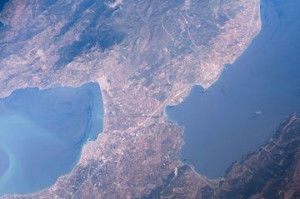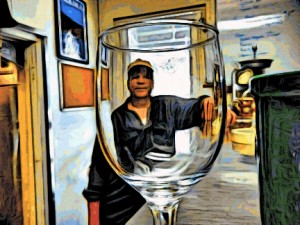Most of the historical ramps I research are generally of a pretty temporary nature: pyramid construction ramps, siege ramps, etc. They’re built for a single purpose and then abandoned or destroyed. They’re machines, and they don’t have a long-term purpose.
I have found a few ramps that are different, though, and one of my favorites is the Diolkos.
 The Diolkos, built by the ancient Greeks, was half ramp, half causeway. It was used to transport ships across the Ithmus of Corinth, saving them a dangerous sea voyage. The ancient Greeks actually dragged the ships overland on it. (You’d think a canal would be easier to use, but canals are a lot harder to build and maintain.) Huge teams of men and oxen would have pulled the boats and cargo across it in about three hours per trip.
The Diolkos, built by the ancient Greeks, was half ramp, half causeway. It was used to transport ships across the Ithmus of Corinth, saving them a dangerous sea voyage. The ancient Greeks actually dragged the ships overland on it. (You’d think a canal would be easier to use, but canals are a lot harder to build and maintain.) Huge teams of men and oxen would have pulled the boats and cargo across it in about three hours per trip.
No one is quite sure when the thing was built, but at best estimate it was in use from 600 BC to 100 AD, which is a pretty good lifespan for a project like that. It was mostly used for shipping but also served a pretty vital role for navies during war.
There isn’t nearly as much information on the Diolkos as I would like out there. The ancient Greeks mostly wrote about their gods and heroes and wars and such, which is disappointing but not unexpected. Most people want entertainment; they’re not looking to find out how the world works.
Today the site has been destroyed in parts by the Corinth Canal, and much of the excavated portions are falling apart due to lack of maintenance and boat traffic on the Canal. It’s not exactly the Parthenon, but it represents a vital look at how the day-to-day functioning of an ancient society actually worked.
Hmm. Maybe I can convince Maggie that we should go to Greece next vacation.
 With ramps, friction is the biggest variable left out; it’s a real pain to calculate. Often, teachers will just do the math with an idealized, frictionless ramp. Makes it really easy for students to figure out but gets a little ridiculous if you try to think about actually trying to use the thing—pure slapstick, really, and slapstick is one kind of humor you don’t want in the workplace.
With ramps, friction is the biggest variable left out; it’s a real pain to calculate. Often, teachers will just do the math with an idealized, frictionless ramp. Makes it really easy for students to figure out but gets a little ridiculous if you try to think about actually trying to use the thing—pure slapstick, really, and slapstick is one kind of humor you don’t want in the workplace. Well, come the day he was to test out the idea, it turns out I’d taught him with the idealized frictionless ramp model. That should have resulted in a mess on its own but, luckily for me, his big mistake had nothing to do with my assistance.
Well, come the day he was to test out the idea, it turns out I’d taught him with the idealized frictionless ramp model. That should have resulted in a mess on its own but, luckily for me, his big mistake had nothing to do with my assistance.